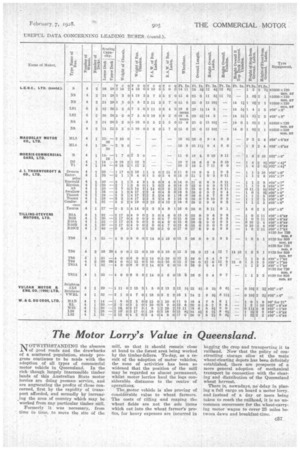The Motor Lorry's Value in Queensland.
Page 143

If you've noticed an error in this article please click here to report it so we can fix it.
ATOTWITHSTANDING the absence of good roads and the drawbacks of a scattered population, steady progress continues to be made with the adoption of all types of commercial motor vehicle in Queensland. In the rich though largely inaccessible timber lands of this Australian State motor lorries are doing yeoman service, and are augmenting the profits of those concerned, first by the rapidity of transport afforded, and secondly by increasing the area of country which may be worked from any particular timber mill.
Formerly it was necessary, from time to time, to move the site of the mill, so that it should remain close at hand to the forest area being worked by the timber-fellers. To-day, as a result of the adoption of motor vehicles, the zone of activities has been so widened that the position of the mill may be regarded as almost permanent, whilst motor lorries haul the logs considerable distances to the centre of operations.
The motor vehicle is also proving of considerable value to wheat farmers. The costs of tilling and reaping the wheat fields are not the sole items which eat into the wheat farmer's profits, for heavy expenses are incurred in
begging the crop -and transporting it to railhead. Now that the policy of constructing storage silos at the main wheat-clearing depots has been definitely established, there are prospects of a more general adoption of mechanical transport in connection with the clearing and distribution of the Queensland wheat harvest.
There is, nowadays, no delay in placing a full cargo on board a motor lorry. and instead of a day or more being taken to reach the railhead, it is no uncommon occurrence for the wheat-carrying motor wagon to cover 25 miles between dawn and breakfast-time.




















































































































































































































